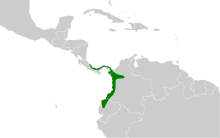Spot-crowned antvireo
| Spot-crowned antvireo | |
|---|---|
| Scientific classification | |
| Domain: | Eukaryota |
| Kingdom: | Animalia |
| Phylum: | Chordata |
| Class: | Aves |
| Order: | Passeriformes |
| Family: | Thamnophilidae |
| Genus: | Dysithamnus |
| Species: | D. puncticeps
|
| Binomial name | |
| Dysithamnus puncticeps Salvin, 1866
| |

| |
The spot-crowned antvireo (Dysithamnus puncticeps) is a species of
Taxonomy and systematics
The spot-crowned antvireo is
Description
The spot-crowned antvireo is 10 to 12 cm (3.9 to 4.7 in) long and weighs 15 to 17 g (0.53 to 0.60 oz). Adult males have a dark gray forehead, crown, and nape heavily marked with white spots. Their ear
Distribution and habitat
The spot-crowned antvireo is found from Cahuita in Costa Rica's Limón Province south through Panama on the Caribbean slope and on the Pacific slope from Panamá Province. Its range continues into Colombia on the lower reaches of the Cauca River and along the country's Pacific slope into northwestern Ecuador as far as Manabí and Santo Domingo de los Tsáchilas provinces. It primarily inhabits the understorey to mid-storey of evergreen forest in the lowlands and foothills. In elevation it ranges from sea level to 800 m (2,600 ft) in Costa Rica, to 500 m (1,600 ft) in Panama, to 1,000 m (3,300 ft) in Colombia, and to 800 m (2,600 ft) in Ecuador.[3][4][5][6][7][8]
Behavior
Movement
The spot-crowned antvireo is thought to be a year-round resident throughout its range.[4]
Feeding
The spot-crowned antvireo feeds mostly on insects and its diet also includes other
Breeding
The spot-crowned antvireo breeds between April and July in Panama and nest-building has been recorded in late August in Colombia. Its breeding season elsewhere has not been determined. One nest was a cup hanging from a branch fork 2 m (7 ft) above the ground. It contained two eggs and both parents incubated them. The incubation period, time to fledging, and other details of parental care are not known.[4]
Vocalization
The spot-crowned antvireo's song is "a rapid...trill, notes not countable, pitch first rising slightly, falling slightly terminally, pace constant initially, then accelerating slightly towards end". Its calls include a "short descending 'chirr' ".[4]
Status
The
References
- ^ . Retrieved 13 March 2024.
- ^ Rasmussen, Pamela, eds. (January 2024). "Antbirds". IOC World Bird List. v 14.1. Retrieved 4 January 2024.
- ^ a b Check-list of North American Birds (7th ed.). Washington, D.C.: American Ornithologists' Union. 1998.
- ^ a b c d e f g h Zimmer, K. and M.L. Isler (2020). Spot-crowned Antvireo (Dysithamnus puncticeps), version 1.0. In Birds of the World (J. del Hoyo, A. Elliott, J. Sargatal, D. A. Christie, and E. de Juana, Editors). Cornell Lab of Ornithology, Ithaca, NY, USA. https://doi.org/10.2173/bow.spcant1.01 retrieved March 13, 2024
- ^ ISBN 0691120706.
- ^ ISBN 978-0-8014-7373-9.
- ^ ISBN 978-0-9827615-0-2.
- ^ ISBN 978-0-8014-8721-7.


